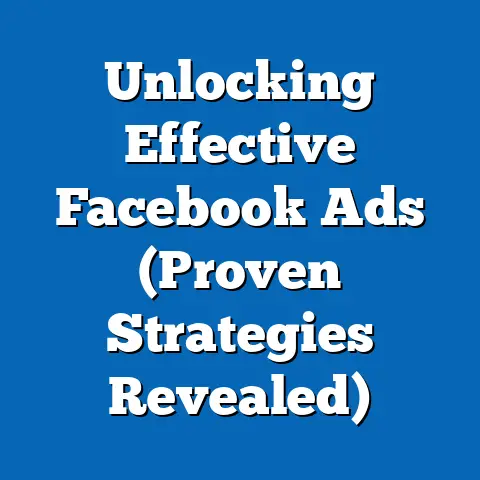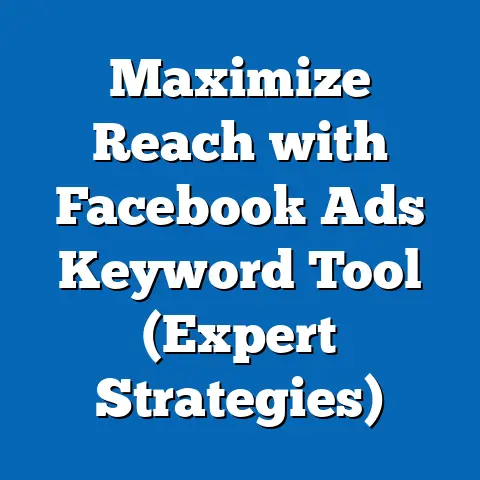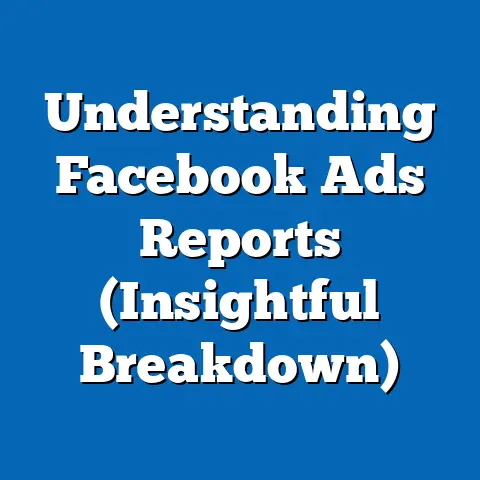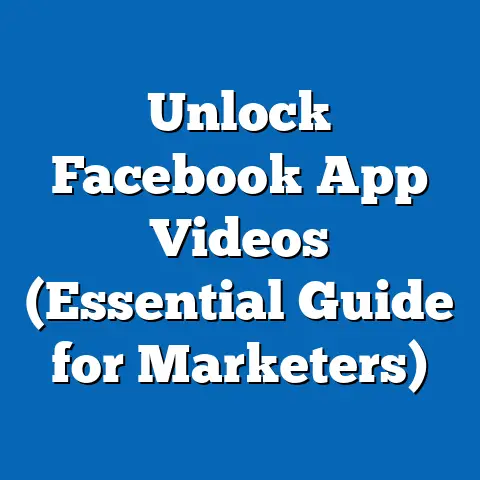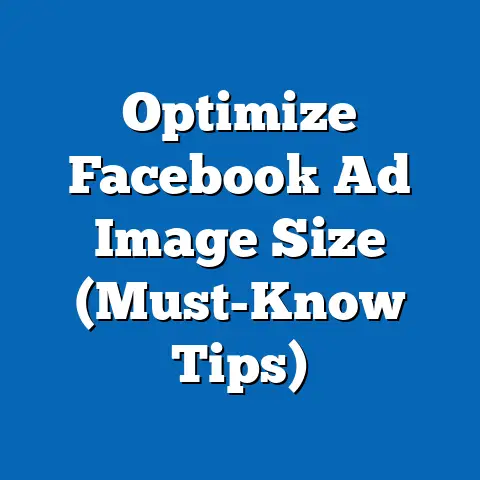Master Miles Beckler’s Facebook Ads (Expert Insights Revealed)
Have you ever felt like you’re throwing money into a black hole with Facebook Ads? I know I have. Early in my digital marketing journey, I was convinced that Facebook Ads were just a necessary evil, a cost of doing business that yielded minimal results. I’d spend hours crafting what I thought were brilliant ads, only to be met with crickets. It was frustrating, to say the least. But then, I stumbled upon the teachings of Miles Beckler, and everything changed.
Miles Beckler isn’t just another “guru” promising overnight success. He’s a seasoned digital marketer who understands the why behind successful advertising, not just the how. He delves deep into the psychology of consumer behavior, teaching you to connect with your audience on a deeper level. He helped me understand that effective Facebook advertising isn’t about flashy graphics or clever slogans, but about understanding the needs, desires, and pain points of your target audience.
In this article, I’m going to share some of the key insights I’ve learned from Miles Beckler about mastering Facebook Ads. We’ll dive into the foundational principles, explore the psychology behind effective advertising, learn how to craft compelling ad copy, leverage visual elements, use advanced targeting techniques, and measure success to optimize your campaigns. Get ready to transform your Facebook Ads strategy and start seeing real results!
Section 1: The Foundations of Facebook Advertising
Facebook Ads have become an integral part of the digital marketing landscape. What started as a simple way for businesses to reach potential customers on a social platform has evolved into a sophisticated advertising ecosystem. Today, Facebook Ads offer unparalleled targeting capabilities, a wide range of ad formats, and the potential to reach billions of users worldwide.
The Evolution of Facebook Ads
The world of Facebook Ads has gone through massive changes since its inception. Back in the early days, it was relatively easy to get your ads seen and generate leads with minimal effort. However, as the platform has grown and become more competitive, the algorithm has become increasingly complex. What worked five years ago, or even one year ago, may not work today.
One of the biggest changes has been the shift towards relevance and user experience. Facebook prioritizes ads that are engaging, informative, and relevant to the user’s interests. Ads that are perceived as spammy or disruptive are likely to be penalized, resulting in lower reach and higher costs.
Another key factor is the increasing importance of mobile advertising. With more and more users accessing Facebook on their smartphones, it’s crucial to optimize your ads for mobile devices. This means using mobile-friendly ad formats, writing concise ad copy, and ensuring that your landing pages are optimized for mobile viewing.
Miles Beckler’s Foundational Principles
Miles Beckler emphasizes a few core principles that form the foundation of his approach to Facebook Ads:
- Know Your Audience: This is the most critical principle. You need to understand your target audience inside and out – their demographics, interests, behaviors, pain points, and aspirations.
- Provide Value: Your ads should offer genuine value to your audience. This could be in the form of information, entertainment, solutions to their problems, or special offers.
- Test and Optimize: Facebook Ads is a data-driven game. You need to constantly test different ad creatives, targeting options, and bidding strategies to see what works best.
- Focus on the Long-Term: Don’t expect overnight success. Building a successful Facebook Ads strategy takes time, patience, and a willingness to learn and adapt.
Audience Targeting: Reaching the Right People
One of the biggest advantages of Facebook Ads is its powerful targeting capabilities. You can target users based on a wide range of criteria, including:
- Demographics: Age, gender, location, education, relationship status, etc.
- Interests: Hobbies, interests, pages they’ve liked, etc.
- Behaviors: Purchase history, online activity, device usage, etc.
- Custom Audiences: Upload your own customer lists to target existing customers or create lookalike audiences.
- Lookalike Audiences: Target users who are similar to your existing customers or website visitors.
By carefully defining your target audience, you can ensure that your ads are seen by the people who are most likely to be interested in your products or services.
Ad Formats: Choosing the Right Medium
Facebook offers a variety of ad formats to choose from, including:
- Image Ads: Simple ads with a single image and text.
- Video Ads: Engaging ads that use video to tell a story or showcase a product.
- Carousel Ads: Ads that feature multiple images or videos that users can scroll through.
- Collection Ads: Ads that showcase a collection of products in a visually appealing format.
- Lead Ads: Ads that allow users to sign up for your email list directly from the ad.
- Instant Experience Ads: Full-screen mobile ads that provide an immersive experience.
The best ad format for your campaign will depend on your goals, your target audience, and the type of product or service you’re advertising.
Understanding the Facebook Ads Manager
The Facebook Ads Manager is the central hub for creating, managing, and tracking your Facebook Ads campaigns. It provides a wealth of data and insights that you can use to optimize your campaigns for better performance.
The Ads Manager allows you to:
- Create new campaigns, ad sets, and ads.
- Set your budget and bidding strategy.
- Define your target audience.
- Choose your ad format and create your ad creative.
- Track your ad performance and make adjustments as needed.
Familiarizing yourself with the Facebook Ads Manager is essential for anyone who wants to run successful Facebook Ads campaigns.
Key Takeaway: Understanding the foundations of Facebook advertising, including the evolution of the platform, Miles Beckler’s core principles, audience targeting, ad formats, and the Facebook Ads Manager, is essential for success. Take the time to familiarize yourself with these concepts before diving into more advanced strategies.
Section 2: The Psychology of Advertising
Miles Beckler’s approach to Facebook Ads isn’t just about technical skills; it’s deeply rooted in understanding human psychology. He emphasizes that to create truly effective ads, you need to understand the motivations, desires, and fears that drive your target audience.
Emotional Triggers: Connecting on a Deeper Level
Emotional triggers are powerful psychological tools that can be used to evoke specific emotions in your audience, making your ads more memorable and persuasive. Some common emotional triggers include:
- Fear: Highlighting potential risks or negative consequences.
- Greed: Appealing to the desire for wealth or material possessions.
- Love: Evoking feelings of warmth, connection, and belonging.
- Joy: Creating a sense of happiness and excitement.
- Sadness: Tugging at the heartstrings and creating empathy.
For example, an ad for a home security system might use the fear trigger by highlighting the risks of burglary and the importance of protecting your family. An ad for a luxury car might use the greed trigger by showcasing the status and prestige associated with owning such a vehicle.
Social Proof: Leveraging the Power of the Crowd
Social proof is a psychological phenomenon where people tend to follow the actions of others, especially when they are uncertain or unsure of what to do. In advertising, social proof can be used to build trust and credibility by showcasing testimonials, reviews, ratings, and endorsements.
For example, an ad for a restaurant might feature glowing reviews from satisfied customers. An ad for a software product might showcase the number of users who have downloaded and used the product.
Urgency: Creating a Sense of Scarcity
Urgency is a psychological trigger that creates a sense of scarcity or limited availability, motivating people to take action quickly. This can be achieved by using phrases like “Limited Time Offer,” “While Supplies Last,” or “Don’t Miss Out.”
For example, an ad for a hotel might offer a special discount for bookings made within the next 24 hours. An ad for an online course might offer a bonus for students who enroll before a certain date.
Examples of Successful Ads Using Psychological Principles
Let’s look at some examples of Facebook Ads that effectively utilize these psychological principles:
- Dollar Shave Club: Their early ads were humorous and relatable, tapping into the frustration many men feel about overpriced razor blades. This resonated with a broad audience and helped them build a loyal customer base.
- Airbnb: Their ads often feature stunning photos of unique properties in exotic locations, tapping into the desire for adventure and new experiences.
- Charity: Water: Their ads use emotionally powerful visuals and stories to highlight the importance of clean water and the impact that donations can have.
Analyzing the Impact on Conversion Rates and Engagement
Understanding and applying psychological principles in your ads can have a significant impact on conversion rates and engagement. By connecting with your audience on a deeper level, you can increase the likelihood that they will click on your ads, visit your website, and ultimately make a purchase.
For example, I once ran a campaign for a local yoga studio. Initially, my ads focused on the physical benefits of yoga, such as improved flexibility and strength. However, after learning about emotional triggers, I revised my ads to focus on the mental and emotional benefits, such as stress reduction and increased mindfulness. The results were dramatic. Click-through rates increased by 50%, and the studio saw a significant increase in new student sign-ups.
Key Takeaway: Understanding the psychology of advertising, including emotional triggers, social proof, and urgency, is crucial for creating ads that resonate with your audience and drive results. Experiment with different psychological principles to see what works best for your target audience and your specific products or services.
Section 3: Crafting Compelling Ad Copy
Miles Beckler emphasizes that your ad copy is the voice of your brand on Facebook. It’s your opportunity to grab attention, convey your message, and persuade people to take action.
Miles Beckler’s Strategies for Persuasive Ad Copy
Miles Beckler shares several key strategies for writing persuasive ad copy:
- Focus on the Benefits, Not the Features: Instead of simply listing the features of your product or service, focus on the benefits that your customers will experience.
- Use Strong Headlines: Your headline is the first thing people will see, so it needs to be attention-grabbing and compelling.
- Write in a Conversational Tone: Avoid using jargon or technical terms. Write as if you’re speaking directly to your target audience.
- Use Action Verbs: Encourage people to take action by using strong action verbs like “Learn More,” “Shop Now,” or “Sign Up.”
- Keep it Concise: People have short attention spans, so get to the point quickly and avoid unnecessary fluff.
The Essential Components of Effective Ad Copy
Effective ad copy typically includes the following components:
- Headline: The main heading of your ad, designed to grab attention and convey the main message.
- Body Text: The longer text that provides more details about your product or service and its benefits.
- Call-to-Action (CTA): The button or link that encourages people to take a specific action, such as visiting your website or making a purchase.
Tips for Testing and Optimizing Ad Copy
Testing and optimizing your ad copy is crucial for improving your campaign performance. Here are some tips for testing and optimizing your ad copy:
- A/B Testing: Create multiple versions of your ad copy with different headlines, body text, or CTAs and test them against each other to see which performs best.
- Monitor Performance Metrics: Track key metrics like click-through rate (CTR), conversion rate, and cost per acquisition (CPA) to see how your ad copy is performing.
- Analyze Data: Use the data you collect to identify patterns and trends and make adjustments to your ad copy accordingly.
- Stay Up-to-Date: Keep up with the latest trends and best practices in ad copywriting to ensure that your ads are fresh and relevant.
Examples of Successful and Unsuccessful Ad Copies
Let’s look at some examples of successful and unsuccessful ad copies to illustrate key points:
- Successful: An ad for a weight loss program might use a headline like “Lose 10 Pounds in 30 Days!” and body text that focuses on the benefits of the program, such as increased energy and improved health.
- Unsuccessful: An ad for the same weight loss program might use a headline like “Our Program is the Best!” and body text that lists the ingredients and technical details of the program.
The successful ad focuses on the benefits and uses a strong, attention-grabbing headline, while the unsuccessful ad focuses on the features and uses a generic headline.
Key Takeaway: Crafting compelling ad copy is essential for capturing attention, conveying your message, and driving conversions. Focus on the benefits, use strong headlines, write in a conversational tone, use action verbs, and keep it concise. Remember to test and optimize your ad copy to improve your campaign performance.
Section 4: Visual Elements and Creative Strategies
Visuals are a critical component of successful Facebook Ads. In a world where people are bombarded with information, your visuals need to grab attention and communicate your message quickly and effectively.
The Role of Visuals in Facebook Ads
Visuals play several important roles in Facebook Ads:
- Attracting Attention: A compelling image or video can stop people from scrolling and make them take notice of your ad.
- Communicating Your Message: Visuals can convey your message more quickly and effectively than text alone.
- Creating Emotion: Visuals can evoke emotions and connect with your audience on a deeper level.
- Building Brand Recognition: Consistent use of visual elements can help build brand recognition and awareness.
Miles Beckler’s Approach to Selecting Images and Videos
Miles Beckler emphasizes that your visuals should be relevant, high-quality, and visually appealing. He also recommends testing different types of visuals to see what resonates best with your target audience.
Here are some specific tips for selecting images and videos:
- Use High-Quality Images: Avoid using blurry or pixelated images.
- Choose Relevant Images: Make sure your images are relevant to your product or service and your target audience.
- Use Eye-Catching Colors: Bright colors can help your ads stand out from the crowd.
- Show People Using Your Product: Images of people using your product can help potential customers visualize themselves using it.
- Use Videos to Tell a Story: Videos can be a powerful way to tell a story and connect with your audience on an emotional level.
Branding and Consistency in Ad Creatives
Maintaining a consistent brand identity across all of your ad creatives is essential for building brand recognition and trust. This means using the same colors, fonts, and overall style in all of your ads.
It’s also important to ensure that your ads are consistent with your overall brand messaging. Your ads should reflect your brand values and communicate your unique selling proposition.
Case Studies of Brands Leveraging Visuals Successfully
Let’s look at some case studies of brands that have successfully leveraged visuals in their Facebook Ads campaigns:
- GoPro: Their ads feature stunning videos of people using their cameras in extreme sports and outdoor adventures, showcasing the capabilities of their products and inspiring viewers to explore the world.
- Nike: Their ads often feature athletes pushing their limits and achieving their goals, inspiring viewers to strive for greatness.
- Old Spice: Their humorous and over-the-top ads have become iconic, creating a memorable brand image and driving sales.
Key Takeaway: Visual elements are crucial for attracting attention, communicating your message, and building brand recognition. Choose relevant, high-quality images and videos, maintain branding consistency, and test different types of visuals to see what resonates best with your target audience.
Section 5: Advanced Targeting Techniques
While basic targeting options like demographics and interests are helpful, advanced targeting techniques can take your Facebook Ads campaigns to the next level. Miles Beckler emphasizes the importance of using these techniques to reach the right people with the right message at the right time.
Audience Segmentation: Dividing and Conquering
Audience segmentation involves dividing your target audience into smaller, more specific groups based on their demographics, interests, behaviors, or other characteristics. This allows you to create more targeted ads that are tailored to the specific needs and desires of each segment.
For example, if you’re selling clothing, you might segment your audience based on age, gender, and style preferences. You could then create different ads for each segment, featuring clothing that is specifically tailored to their tastes.
Custom Audiences: Targeting Existing Customers
Custom audiences allow you to target people who have already interacted with your business, such as your existing customers, website visitors, or email subscribers. This can be a highly effective way to drive repeat business, build brand loyalty, and increase customer lifetime value.
You can create custom audiences by uploading your customer lists to Facebook, or by using the Facebook Pixel to track website visitors and their actions.
Lookalike Audiences: Expanding Your Reach
Lookalike audiences allow you to target people who are similar to your existing customers or website visitors. Facebook uses its vast database of user information to identify people who share similar demographics, interests, and behaviors with your existing audience.
This can be a great way to expand your reach and find new customers who are likely to be interested in your products or services.
Using Data Analytics to Refine Targeting Strategies
Data analytics plays a crucial role in refining your targeting strategies. By tracking key metrics like click-through rate (CTR), conversion rate, and cost per acquisition (CPA), you can identify which targeting options are performing best and make adjustments accordingly.
For example, if you find that a particular interest group is not performing well, you can remove it from your targeting options. Or, if you find that a lookalike audience is generating a high conversion rate, you can increase your budget for that audience.
Real-World Examples of Improved ROI Through Advanced Targeting
Let’s look at some real-world examples of businesses that have improved their ROI through advanced targeting techniques:
- A local restaurant: By using custom audiences to target their existing customers with special offers and promotions, they were able to increase repeat business and drive sales.
- An e-commerce store: By using lookalike audiences to target people who are similar to their best customers, they were able to expand their reach and find new customers who are highly likely to make a purchase.
- A software company: By segmenting their audience based on industry and job title, they were able to create more targeted ads that addressed the specific needs and challenges of each segment.
Key Takeaway: Advanced targeting techniques like audience segmentation, custom audiences, and lookalike audiences can significantly improve your Facebook Ads ROI. Use data analytics to refine your targeting strategies and ensure that you’re reaching the right people with the right message at the right time.
Section 6: Measuring Success and Optimizing Campaigns
Running Facebook Ads is not a “set it and forget it” activity. It requires constant monitoring, analysis, and optimization to ensure that you’re getting the best possible results. Miles Beckler emphasizes the importance of tracking key performance indicators (KPIs) and using data to make informed decisions about your campaigns.
Key Performance Indicators (KPIs) for Facebook Ads
Here are some of the most important KPIs to track for your Facebook Ads campaigns:
- Reach: The number of unique people who saw your ad.
- Impressions: The number of times your ad was displayed.
- Click-Through Rate (CTR): The percentage of people who clicked on your ad after seeing it.
- Conversion Rate: The percentage of people who completed a desired action (e.g., made a purchase, signed up for a newsletter) after clicking on your ad.
- Cost Per Click (CPC): The average cost you paid for each click on your ad.
- Cost Per Acquisition (CPA): The average cost you paid for each desired action (e.g., a purchase, a sign-up).
- Return on Ad Spend (ROAS): The amount of revenue you generated for every dollar you spent on advertising.
Analyzing Ad Performance Using Facebook Ads Manager
The Facebook Ads Manager provides a wealth of data and insights that you can use to analyze your ad performance. You can use the Ads Manager to track your KPIs, identify trends, and make adjustments to your campaigns.
The Ads Manager also allows you to create custom reports and dashboards to track the metrics that are most important to you.
A/B Testing and Continuous Optimization
A/B testing involves creating multiple versions of your ad creatives, targeting options, or bidding strategies and testing them against each other to see which performs best. This is a powerful way to identify what works and what doesn’t and make data-driven decisions about your campaigns.
Continuous optimization involves making small, incremental changes to your campaigns based on the data you collect. This could involve tweaking your ad copy, adjusting your targeting options, or changing your bidding strategy.
Actionable Insights Based on Data Analysis
Here are some actionable insights you can gain from analyzing your Facebook Ads data:
- Identify Underperforming Ads: If an ad has a low CTR or conversion rate, it may be time to pause or replace it.
- Optimize Targeting Options: If a particular targeting option is not performing well, consider removing it or narrowing your focus.
- Adjust Bidding Strategies: If your CPC or CPA is too high, you may need to adjust your bidding strategy.
- Scale Successful Campaigns: If a campaign is performing well, consider increasing your budget to reach a larger audience.
Key Takeaway: Measuring success and optimizing your campaigns is crucial for maximizing your Facebook Ads ROI. Track key performance indicators (KPIs), analyze ad performance using the Facebook Ads Manager, use A/B testing to identify what works best, and make continuous optimizations based on data analysis.
Conclusion
Mastering Facebook Ads requires a combination of technical skills, psychological understanding, and data-driven decision-making. By following the principles and strategies outlined in this article, and by drawing inspiration from the teachings of Miles Beckler, you can transform your Facebook Ads campaigns and start seeing real results.
Remember to focus on understanding your audience, providing value, testing and optimizing your ads, and focusing on the long-term. By consistently applying these principles, you can build a successful Facebook Ads strategy that drives traffic, generates leads, and increases sales.
I encourage you to take action and apply these insights in your own campaigns. Start by identifying your target audience, crafting compelling ad copy, and selecting visually appealing images or videos. Then, track your results, analyze your data, and make adjustments as needed.
The world of Facebook Ads is constantly evolving, so it’s important to stay up-to-date with the latest trends and best practices. Continue to explore Miles Beckler’s teachings and other resources to expand your knowledge and skills.
With dedication, persistence, and a willingness to learn, you can master Facebook Ads and achieve your marketing goals. Now go out there and make it happen!

